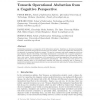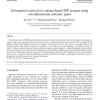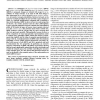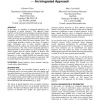147
Voted
CVPR
2012
IEEE
13 years 2 months ago
2012
IEEE
Activity recognition in video is dominated by low- and mid-level features, and while demonstrably capable, by nature, these features carry little semantic meaning. Inspired by the...
119
click to vote
PAMI
2012
13 years 2 months ago
2012
— A novel framework to context modeling, based on the probability of co-occurrence of objects and scenes is proposed. The modeling is quite simple, and builds upon the availabili...
96
Voted
COLING
2010
14 years 7 months ago
2010
The aim of this study is to use the word-space model to measure the semantic loads of single verbs, profile verbal lexicon acquisition, and explore the semantic information on Chi...
123
click to vote
COLING
2010
14 years 7 months ago
2010
We explore the near-synonym lexical choice problem using a novel representation of near-synonyms and their contexts in the latent semantic space. In contrast to traditional latent...
118
Voted
SMC
2010
IEEE
14 years 11 months ago
2010
IEEE
—This study examines the ability of nonnegative matrix factorization (NMF) as a method for constructing semantic spaces, in which the meaning of each word is represented by a hig...
128
click to vote
NLE
2010
14 years 11 months ago
2010
Thesauri, that list the most salient semantic relations between words have mostly been compiled manually. Therefore, the inclusion of an entry depends on the subjective decision o...
91
Voted
IGPL
2006
15 years 14 days ago
2006
Diminishing awareness is a consequence of the information explosion: disciplines are becoming increasingly specialized; individuals and groups are becoming ever more insular. This...
130
click to vote
CN
2007
15 years 14 days ago
2007
The widespread use of RDF-based information necessitates efficient information retrieval techniques in wide-area networks. In this paper, we present Dynamic Semantic Space, a sche...
113
click to vote
CIVR
2006
Springer
15 years 4 months ago
2006
Springer
A combination of query-by-visual-example (QBVE) and semantic retrieval (SR), denoted as query-by-semantic-example (QBSE), is proposed. Images are labeled with respect to a vocabula...
104
click to vote
HT
1998
ACM
15 years 4 months ago
1998
ACM
In this paper, we introduce an integrated approach to the development of spatial hypertext. This approach brings together several theories and techniques concerning semantic struc...




